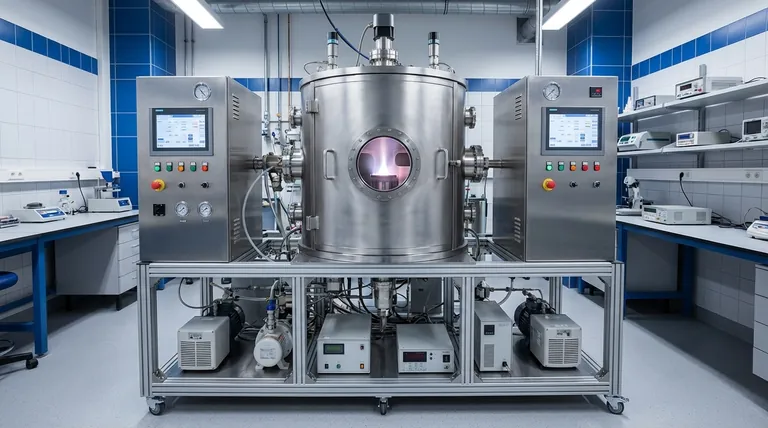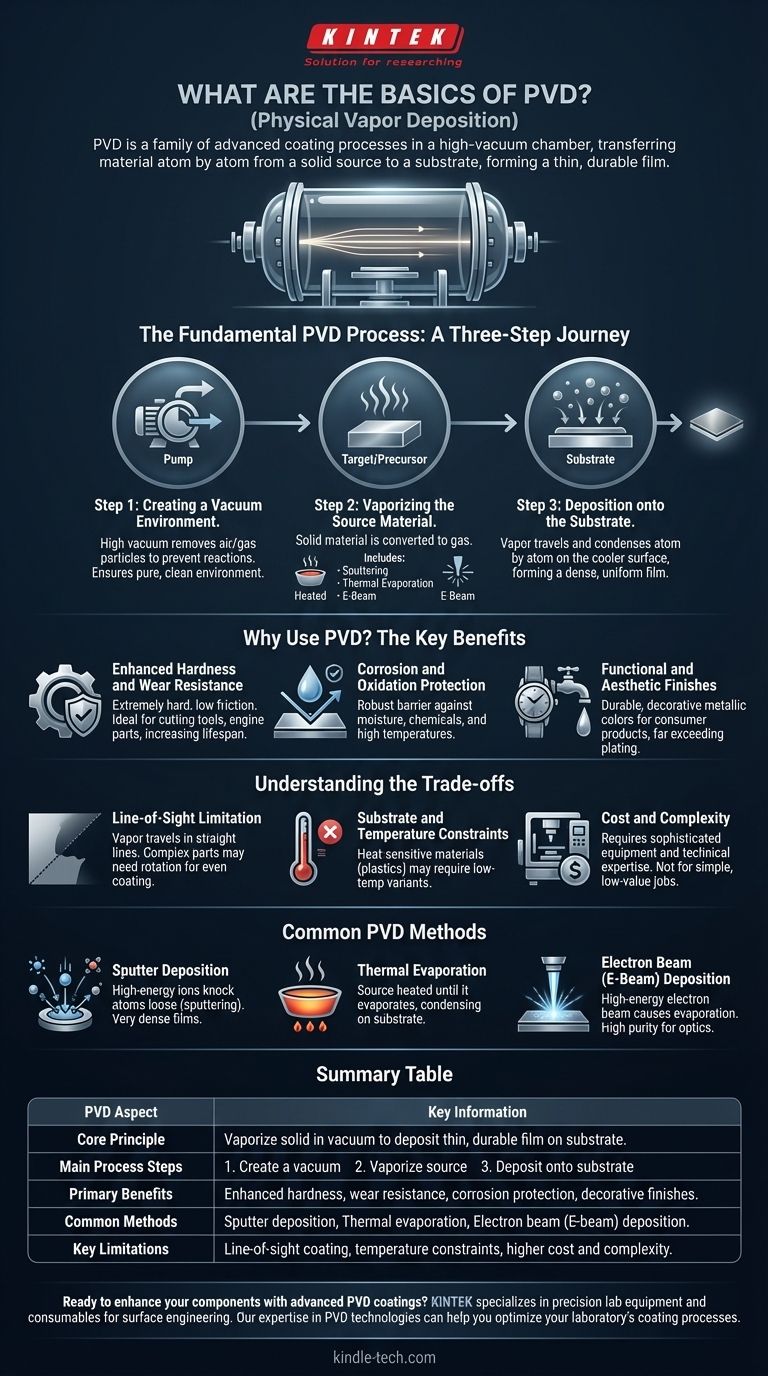In simple terms, Physical Vapor Deposition (PVD) is a family of advanced coating processes conducted inside a high-vacuum chamber. The fundamental principle involves taking a solid source material, converting it into a vapor, and then allowing that vapor to condense onto a target object, or substrate, as a very thin and durable film. This process physically transfers material atom by atom, creating coatings with significantly enhanced properties.
PVD is not a single technique but a category of vacuum-based methods for engineering a material's surface. Its core purpose is to deposit a high-performance thin film from a physical source, fundamentally improving a component's hardness, wear resistance, or corrosion protection without altering its underlying structure.

The Fundamental PVD Process: A Three-Step Journey
Every PVD process, regardless of the specific type, follows the same fundamental sequence of events inside a vacuum chamber. Understanding this sequence is key to grasping how PVD works.
Step 1: Creating a Vacuum Environment
The entire process must occur under a high vacuum. This is critical because it removes air and other gas particles that could otherwise react with or impede the vaporized coating material as it travels to the substrate.
A clean, empty environment ensures the final coating is pure and adheres properly to the surface.
Step 2: Vaporizing the Source Material
This is the "Physical Vapor" creation step. A solid material, often called a "target" or "precursor," is converted into a gaseous state. The method used for this vaporization is what primarily distinguishes the different types of PVD.
This can be achieved by heating the material until it evaporates, bombarding it with high-energy ions to knock atoms loose (sputtering), or striking it with a high-energy electron beam.
Step 3: Deposition onto the Substrate
The vaporized material travels through the vacuum chamber and strikes the substrate (the part being coated). Upon contact with the cooler surface of the substrate, the vapor condenses back into a solid state.
This condensation builds up atom by atom, forming a thin, dense, and highly uniform film across the surface of the part.
Why Use PVD? The Key Benefits
PVD is used when a component's surface needs properties that the bulk material cannot provide. The goal is to add functionality or durability directly where it's needed most: the surface.
Enhanced Hardness and Wear Resistance
PVD coatings are often extremely hard and have a low coefficient of friction. This makes them ideal for cutting tools, engine components, and other parts exposed to high wear, dramatically increasing their operational lifespan.
Corrosion and Oxidation Protection
The deposited film acts as a robust barrier between the substrate and the environment. This shield protects the underlying material from moisture, chemicals, and high temperatures that would otherwise cause rust, corrosion, or oxidation.
Functional and Aesthetic Finishes
Beyond industrial performance, PVD is widely used to apply durable, decorative finishes to consumer products. It can produce a wide range of metallic colors on items like watches, faucets, and hardware, providing a finish far more resilient than traditional plating.
Understanding the Trade-offs
While powerful, PVD is not a universal solution. Understanding its limitations is critical for making an informed decision.
Line-of-Sight Limitation
Most PVD processes are "line-of-sight," meaning the vaporized material travels in a straight line. Areas of a complex part that are hidden or shadowed from the vapor source will not receive an even coating. Fixturing and part rotation are often required to manage this.
Substrate and Temperature Constraints
The deposition process often involves heat, which can be a problem for temperature-sensitive substrates like certain plastics or polymers. While low-temperature PVD variants exist, it remains a key consideration.
Cost and Complexity
PVD requires sophisticated and expensive vacuum equipment, and the process itself demands significant technical expertise to control. It is an industrial process, not a simple workshop technique, making it less suitable for one-off jobs or low-value components.
A Look at Common PVD Methods
The term "PVD" covers several distinct technologies. The primary difference between them is how they create the vapor from the solid source material.
Sputter Deposition
In sputtering, the target material is bombarded with high-energy ions. This acts like a subatomic game of billiards, where the ions knock atoms loose from the target, "sputtering" them toward the substrate. It produces very dense and uniform films.
Thermal Evaporation
This is one of the simplest methods. The source material is placed in a crucible and heated in the vacuum until it evaporates, much like boiling water. The resulting vapor rises and condenses on the substrate held above it.
Electron Beam (E-Beam) Deposition
This method uses a magnetically focused beam of high-energy electrons to strike the source material. The beam generates intense, localized heat, causing the material to evaporate with high efficiency and purity, making it ideal for optical and electronic applications.
Making the Right Choice for Your Goal
Selecting a PVD process depends entirely on the desired outcome for your component.
- If your primary focus is maximum durability and wear resistance: Sputtering or cathodic arc deposition are often preferred for their dense, highly adherent, and hard coatings.
- If your primary focus is high-purity films for optics or electronics: E-beam or thermal evaporation provide excellent control over deposition purity and rate.
- If your primary focus is coating a heat-sensitive plastic or polymer: Specialized low-temperature sputtering processes may be the only viable solution.
Ultimately, PVD is a powerful tool for engineering a material's surface to perform far beyond its natural capabilities.
Summary Table:
| PVD Aspect | Key Information |
|---|---|
| Core Principle | Vaporizing a solid material in a vacuum to deposit a thin, durable film on a substrate |
| Main Process Steps | 1. Create a vacuum 2. Vaporize the source material 3. Deposit onto the substrate |
| Primary Benefits | Enhanced hardness, wear resistance, corrosion protection, and decorative finishes |
| Common Methods | Sputter deposition, Thermal evaporation, Electron beam (E-beam) deposition |
| Key Limitations | Line-of-sight coating, temperature constraints, higher cost and complexity |
Ready to enhance your components with advanced PVD coatings?
KINTEK specializes in precision lab equipment and consumables for surface engineering applications. Our expertise in PVD technologies can help you achieve superior hardness, wear resistance, and corrosion protection for your critical components.
Contact us today to discuss how our PVD solutions can optimize your laboratory's coating processes and deliver exceptional results for your specific application needs.
Visual Guide

Related Products
- HFCVD Machine System Equipment for Drawing Die Nano-Diamond Coating
- Vacuum Hot Press Furnace Machine for Lamination and Heating
- 915MHz MPCVD Diamond Machine Microwave Plasma Chemical Vapor Deposition System Reactor
- Laboratory Sterilizer Lab Autoclave Pulse Vacuum Lifting Sterilizer
- Laboratory Sterilizer Lab Autoclave Vertical Pressure Steam Sterilizer for Liquid Crystal Display Automatic Type
People Also Ask
- Is sputtering a PVD? Discover the Key Coating Technology for Your Lab
- How do CVD diamonds grow? A Step-by-Step Guide to Lab-Grown Diamond Creation
- How is diamond coating made? A Guide to CVD and PVD Methods
- How do you calculate coating coverage? A Practical Guide to Accurate Material Estimation
- What is microwave plasma CVD? A Guide to High-Purity Diamond and Material Synthesis



















